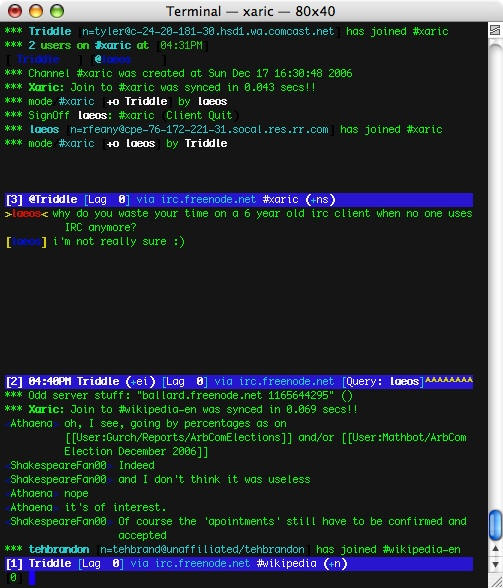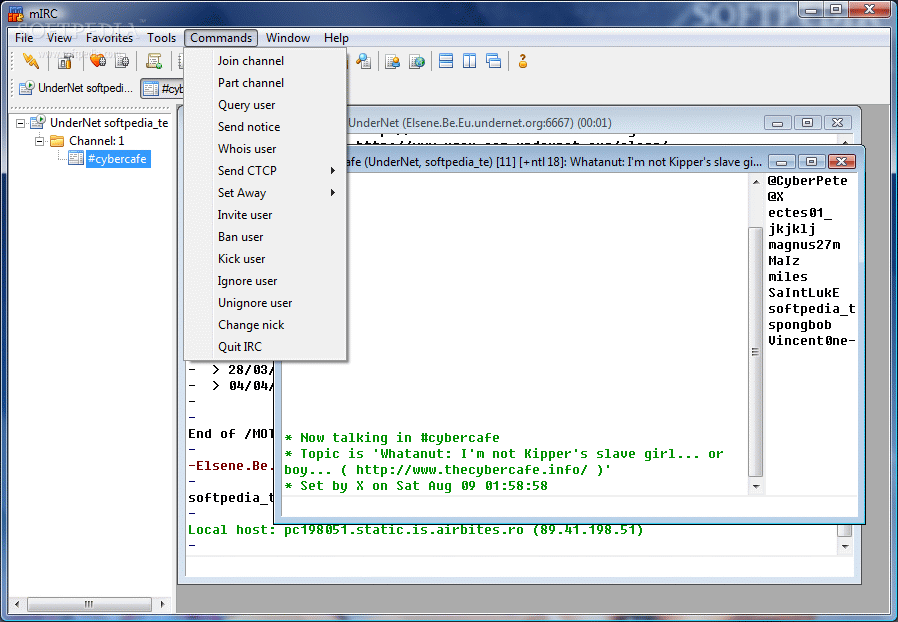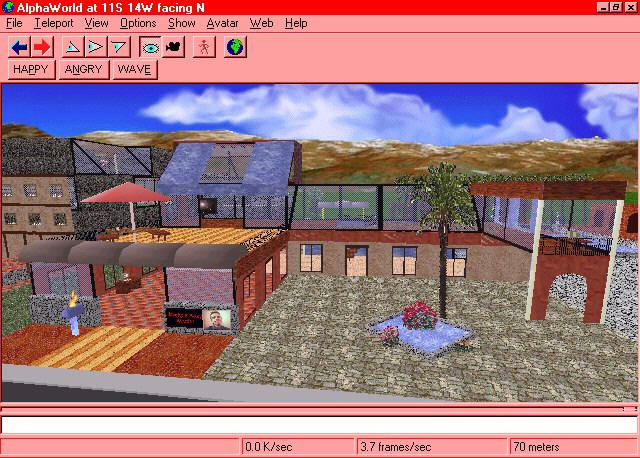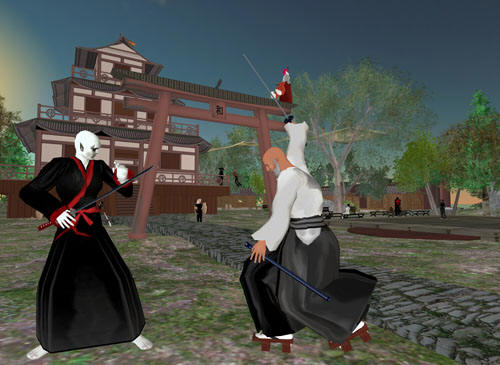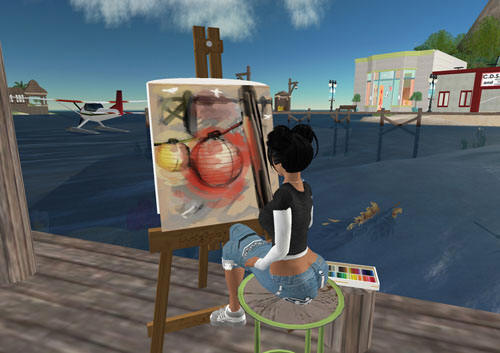My experience had been that IRC was an extremely powerful program. Being able to 'talk' to any one of thousands of people, especially globally, is a liberating act. Many minority nationalities in Australia found communication via the keyboard overcame racial barriers. My multicultural students naturally took to IRC, chatting to overseas nationals on specially set up channels; women also feel a sense of freedom on the keyboard, whether it be from the anonymity or the sense of openness that IRC engenders. Whatever the reasons, IRC (and other chat systems) are addictive - the record for non-stop IRC I believe belongs to a female student - 72 hours, non-stop, no breaks! My question was whether the same addiction is true of the new chat systems?
WEB CHATS
A Web chat systems is usually based on a room metaphor. You access the chat room URL,
through a browser such as Netscape or Mosaic. Each "room" is in fact a HTML file of conversation, which a Web user accesses, typically together
with a Web form for replies. The would-be chatter fills out the form, submits it to the Web server, which then changes the file you originally requested. Your "post" turns up the
next time anyone requests the HTML file; you also cannot 'see' your speech act until you next click on the reload button. Hey presto - interactive chatting - except that the whole process is
not real-time, taking quite a few seconds to actually 'say' something.
The beauty of Web chat systems is that they are totally anonymous - there is no way
anyone can tell who you are. The only record of you accessing the Web server is your domain name e.g. someone from such and such system used the chat server. Anonymity breeds uninhibited
behaviour, thus many Web chats contain mightily gratuitous conversation - swearing, obscene remarks and titillating behaviour are the norm. And since these chats are using HTML, a user can
(but seldom does) include inline images, audio and hypertext links right in the middle of a conversation. Web chats are not the place for children, even if they can read, so be warned!
There are dozens of chat links references on the WWW. One of the biggest collections
of links to other web chats is Deanna's home page at http://perry.gulfnet.com/user_pages/deanna/DWORLD8.HTM. Deanna lists 330 chat links which have to be all clicked on to experience. No
other information is given on these systems. It is like having 330 doors in front of you which look all the same. "Pick a door" says the sign above.
One of the oldest Web chat hangouts is Bianca's Smut Shack. This system has been around for around for nearly 2
years and has a cult following. Bianca's system has a number of sophisticated and well-thought out extras.
Here is a summary of the choices available: Terms of Use; Good Manners Guide; Navigational Aids; bianca's
HeartBeat; bianca's Shack Map; Foyer; Sign-Up Board; Altar; Bedroom; bianca's Golden Apple Cafe; HallWay; Bathroom; The Communal Stall; The
Pillow Talk Lounge; Guest; Parlor; Closet; BookCase; Kitchen; Pantry; Basement and so on.
One of the nice (and oft copied) things about Bianca's shack is that
you can search for a friend, if you know their Web nickname. The "heartbeat" is a selection of the last few lines of conversation from
all the rooms. All the rooms have a sign-up bulletin board so you can register real or fictitious name, fantasies and addresses. You can gender change if you wish to, and nobody will be any
the wiser. The system caters for all tastes including hetero, gay, and S&M. The actual conversation however verges on boring (for me). You cannot get turned on by Web chatting, at least
in my opinion. Others might disagree with me.
The Web has become almost ubiquitous these days. Net users in countries which have little or no access to IRC or
MUD's (e.g. Russia, China) can get to Web chats. So you will find a United Nations of chatters on any one system. IRC in fact is unknown to many Web chatters, who have been brought up on
*slow* conversations and a complete dependence on their mouse clicks.
TEXT-BASED CHAT SYSTEMS
The standing of chat systems in Australia is not high. Most system administrators of
corporate or educational organisations view chatting as a sheer waste of time. IRC is outlawed at most Australian university sites, and a completely unknown application on many business
systems. While some time is used chatting, this is tantamount to saying that in the real world, coffee breaks, and lunch hours should be banned. Just as we need time off to recuperate from
full-time work in our day to day jobs, we also need time off online. Chat systems provide this much-needed recreational diversion, and as long as chatting is not abused, new kinds of
professional online relationships can be created. I have often found help and support from IRC friends.
JWWells has a page of 130+ worldwide 'boutique' chat salons which are mostly accessed
through telnet: (http://chat.carleton.ca/~jwwells/springer.html). These systems are a mixture of MUD's, MOO's and plain old chatting rooms.
Anyone who has ever used a chat, will immediately recognise the vt-100 interface
problems such as interruptions to your text from other users, the echo effect when you type a sentence, and when it turns up again on the screen, and the vulnerability of the telnet
connection to every possible network error and hiccup.
Even given these glitches, text-based chat is still the most popular form of
communication after e-mail. There are those who swear by IRC, those who will only use MUD's and those who eschew anything except local chat rooms.
INTERNET RELAY CHAT
IRC is still by far the largest of the text chat systems in the world. The number of users
of IRC is immeasurable. When I last logged in in May there were about six or seven thousand users. Two months later, I am amazed to see 20,000 users and 6,000 channels formed. This is true
even though there are several alternate subnets available as well. The original author of IRC, Jarkko Oikarinen told me in 1994 that he thought that IRC was too big then. He said that he
thought that IRC should split into several subnets, in order to speed things up a bit, and take the strain off the servers and the voluntary 'ops' who admnister the worldwide IRC network. In
fact this is exactly what has occurred. Here is a list of the current IRC networks:
Efnet
Efnet (Eris Free) is the largest and "main" IRC with about 20,000 online
users on an average day. It is massive in terms of size and has lots of older, less effective scripts, meaning problems with lag, netsplits, op hacking and various kinds of flame wars.
However it is still the most popular IRC network. This is an Efnet FAQ at http://nearnet.gnn.com/gnn/helpdesk/tools/irc.html. For an Efnet server list you can try the ftp site cs-ftp.bu.edu
in the irc/support/ directory. There are a few Efnet telnet servers, but they are usually busy or very lagged (see http://uptown.turnpike.net/L/Larry14/serverhtml). Check alt.irc newsgroup
on the Usenet for updates.
Undernet
The Undernet is the main alternative to the Efnet, and is considered by some to be
the friendly IRC. (I actually disagree with this assumption.) The Undernet is growing in size very rapidly - when I connected in July it had 13,000 users online and 4,000 channels! Connect
in Australia to the irc server au.undernet.org (often split), or overseas to ca.undernet.org. Or you can connect directly to the Undernet via telnet. The Undernet homepage can be found at
http://www2.undernet.org:8080/~cs93jtl/Undernet.html with the FAQ found at http://www2.undernet.org:8080/~cs93jtl/underfaq/index.html.
World Wide Freenet IRC Network
This is a brand new IRC Network that is connecting a link of freenet IRC servers,
throughout the world. You can get info on it if you mail to irc-admin@afn.org,or visit this web site at http://www.afn.org/afnirc/wwfin.html or connect to irc.afn.org through your IRC
client. There were only a hundred users, on 20 channels when I connected in July.
Chiron
Chiron is a Canadian based IRC that caters mostly to game channels like channel #musicrb
which is a music trivia channel, and channel #Riskybus which is a very popular but tricky "Jeopardy" type game. Channel RiskyBus can also be found on Efnet and Undernet. It was
called #Jeopardy until Sony threatend to sue. The server for Chiron is chiron.cs.uregina.ca 6667
Iaonet
Iaonet (Overnet) is an alternative to the Undernet, but has not really caught on yet.
It usually has less then 20 users on it. The OverNet server list can be found at http://uptown.turnpike.net/L/Larry14/onsl.txt. The Iaonet also has a FAQ (http://uptown.turnpike.net/L/Larry14/IAOnetFAQ.txt).
KidLink
KIDLINK IRC is a private network for participants in KIDLINK: Global Networking for
Youth 10-15. Registration is required for use of KIDLINK IRC. Information about KIDLINK can be located at http://www.kidlink.org. For more information, contact irc-mgr@kidlink.ccit.duq.edu.
DalNet
Dalnet was created by The Efnet's #startrek users as a quiet place where they could
run their channel without having to deal with op hacks and netsplits. The people who run Dalnet capitulate that it is not just for trekkies anymore. Dalnet is the only IRC which enables
people to have nicknames as long as 30 characters (most IRCs only permit 9). It usually has about 30 people/bots on it. The Dalnet Homepage (http://www.dal.net/dalnet/) has a FAQ and server
list. Or you can connect directly to the Dalnet via telnet telnet.dal.net 12345.
NetherNet
NetherNet is another smaller IRC thats is relatively new. It has 2 servers
irc.nether.net 6667 and irc.superlink.net 6667
LinuxNet/SysNet
The LinuxNet is an IRC devoted to linux and help with linux software and all computer
system's users.There is a LinuxNet Homepage. For a list of servers you can finger irc@blackdown.org or look at LinuxNet server list.
IdealNet
Idealnet (MTSUnet) has joined LinuxNET. It has a telnet server: 204.96.8.3 (login as
irc) that lets you connect directly.
Japanese IRC
If you do a /list in IRC you will often see very strange channels listed which you
simply cannot access. These are the kanji characters of Japanese IRC. Only people with kanji keyboards can use these channels. The Japanese system is quite small, less than 200 users, and
IRC documentaion in the Japanese language (http://skylark.ics.es.osaka-u.ac.jp/ircjapan/doc-request.txt). Here is the server list for the Japanese IRC - http://foolhp.ap.kagu.sut.ac.jp/~hoshi/kiso/jirc.html).
The Japanese IRC users Homepage can be found at http://skylark.ics.es.osaka-u.ac.jp/ircjapan/).
Taiwan Big-5/QuestNet
The Taiwan Big-5 is an IRC with most of its servers based in Taiwan, but it has some
American servers which are called QuestNet. Most of this IRC is in ascii, but people can also use kanji code (see http://uptown.turnpike.net/L/Larry14/kanji.html) or Big-5 code in order to
type with Chinese characters. Here is the server list for the Taiwan Big-5/QuestNet (http://uptown.turnpike.net/L/Larry14/twsl2.txt). You can also connect directly to this irc via telnet.
ZAnet/South African IRC
The South African IRC has all its servers based in South Africa, but 3 of the 4
servers will let anyone on, even if you dont live in the .za domain. A server list for it can be found at the #za Homepage (http://www.active.co.za/zairc). It has been separted from the
Efnet for about 6 months due to bandwidth shortage, but may reconnect when that problem is solved. During the day (South Africa time) it usually has 30-50 people on it.
Australian APANA IRC
The APANA IRC is a single IRC server on the Australian Public Access Networks
Association in Sydney, Australia. It has a fairly small, but loyal user base. The person who runs it will be talking to other APANA sysadmins nationwide sometime in the near future about
expanding to take in most of the APANA network. The server is triode.apana.org.au 6667
INTERNET RELAY CHAT THEATRE
One of the most interesting uses of IRC has been to "perform" Shakespearean plays on the Internet. The
Hamnet Players from Bath in the UK, debuted the concept of Internet Theatre, a participatory performance art forum, in December 1993 with a production of "Hamnet," an 80-line
version of "Hamlet," which was repeated in February 1994 with Ian Taylor, of the Royal Shakespeare Company, in the title role.
The theatre company's program notes say it all: "The debut performance of 'Hamnet'
was interrupted by a thunderstorm which cut the producers' online access; the play had to be restarted after the producers logged back on via Taiwan. The second performance was enlivened by
a bot which accidentally killed Hamlet halfway through the production. Notwithstanding disaster, both productions were received with enthusiasm by participants and audience alike."
They continue in 1996 by saying that today the company boldly marches forward with a
160-line version of Macbeth, dedicated to the original author. The plot outline has been preserved, but the text has been mercilessly corrupted in keeping with the expected cultural level of
the audience. Also, since they are convinced Shakespeare would never have used Apple hardware if he had known there was a choice, the play has been re-titled in IBM mode.
Check out the Shakespearean performance of the decade at
http://www.bath.ac.uk/~abpgah/pcbeth.html!
Performances of Shakespearian plays are now performed in Second Life (see below)
3D CHAT
AlphaWorld is one of a new breed of virtual reality chat systems created by Worlds
Inc, who are also responsible for Worlds Chat (reviewed in YC Sep, 1995). Here is supposed to be the ultimate in graphical chatting. The blurb from their Web page says that AlphaWorld is
"a virtual place populated by real people, AlphaWorld takes social computing to the next level. By immigrating to AlphaWorld you become one of its citizens and help to shape it. You
acquire and develop property, assume an online persona, and interact in and with a living, breathing, multiuser community. This is not some preprogrammed simulation - it is as unpredictable
and unique as the individuals who help create it. Including you."
I downloaded the 830K executable and booted up AlphaWorld. The system forces you to
register via e-mail so that you can receive an "immigration" number. You then click on the alphaworld client and input your name, nickname, password and number. Immediately you
click OK you are transported to ground zero replete with other avatars. Here you can chat, and the words appear on your head, or you can teleport to other alphaworlds. I found the whole
process to be a little laborious, with the chatting taking second place to backgrounds and all the movement taking place. The scenery takes up a lot of bandwidth, and so interaction between
humans is somewhat minimal. If you want to say "Gee whizz" then go ahead, but if you want to chat to real people then IRC, or even Web Chat is better by far.
The Palace (http://www.thepalace.com/) is a bit different insofar as you download a
huge file (4.8Mb) so that you have all the backgrounds, sounds, even a synthesized voice for speaking whatever you type on other users' computers.
The Palace's client meshes with Web browsers providing real-time interactivity
between users who appear initially as cartoon images. If you register your client, you can change your appearance, or avatar, by importing photos and graphics or selecting from a set of
identities included in the software.
Once inside a Palace environment, or server, it is possible to view and talk with
other people in the same room, move between "rooms," talk privately, make sounds and change avatars as you move throughout any Palace environment. If you pay US$25 you receive a
password to unlock the server software allowing anyone to create their own Palace for the PC, Mac and UNIX platforms. In fact the Unix beta server was free at the time of writing this
article.
Some of the alternative Palace sites include the House of Blues, Palace in
Wonderland, a Virtual Vegas Craps site, German and French sites, a 3D world created especially for the new film Multiplicity, the Jesus Lizard Palace, the Golf Palace, Rainbow Alley,
Metroverse, and others.
The film site, created by Sony Pictures Entertainment on July 3 announced that Michael Keaton, star of this
summer's hotly awaited comedy Multiplicity, will chat with fans in a 3D world on Multiplicity's site. Keaton's chat took place at 7 p.m. on
Thursday, July 11 heralding the film's opening on Wednesday, July 17.
From the Web press release: "The Multiplicity Web site brings text chats to life
through its Palace environment where users can see and interact with other avatars in the environment. The Palace area in the Multiplicity Web site has been custom-designed to resemble the
sets in the film. The "lab" welcomes avatars to enter the cloning vat where they will emerge as clones of Keaton's character. Filled with Keaton clones, the Palace will give
visitors the chance to experience Multiplicity first hand. The real Keaton, whose avatar will be identifiable through a distinguishing mark, will be the first film star ever to gab with fans
in a Palace environment."
The Palace is a production of Time-Warner and has some of the most stunning
backgrounds found anywhere on the 'net. I have downloaded the free Unix server and will be attempting to try out scripting my own Palace world for research/teaching purposes as soon as a
possible. This technology is worth a second look.
Second Life (from Wikipedia)
Ten years later we now have Second Life., which is a virtual world developed by
Linden Lab on June 23, 2003, and the most successful, albeit controversial of
the 3D worlds on the Internet. The Second Life Viewer enables its users, to
interact with each other through avatars - 3D models of themselves. Residents
can explore, meet other residents, socialize, participate in individual and
group activities, and create and trade virtual property and services with one
another, or travel throughout the world, which residents refer to as the grid.
Second Life caters for users aged over eighteen, while its sister site Teen
Second Life is restricted to users aged between thirteen and eighteen.
Second Life does not have a designated objective, nor traditional game play
mechanics or rules. As it does not have any stipulated goals it is irrelevant to
talk about winning or losing in relation to Second Life. Second Life contains an
extensive world that can be explored and interacted with, and it can be used
purely as a creative toolset if the user so chooses. However, the vast majority
of users use Second Life primarily as a social meeting place and as an
entertainment medium.
Second Life is used as a platform for education by many institutions, such as
colleges, universities, libraries and government entities. There are over one
hundred regions used for educational purposes covering subjects such as
chemistry and English. Instructors and researchers in Second Life favor it
because it is more personal than traditional distance learning. Research has
uncovered development, teaching and/or learning activities which use Second Life
in over 80 percent of UK universities. At least 300 universities around the
world teach courses or conduct research in SL. New educational institutions have
also emerged that operate exclusively within Second Life, taking advantage of
the platform to deliver a high quality service to a world wide audience at low
cost.
Religious organizations have also begun to open virtual meeting places within
Second Life. In early 2007, LifeChurch.tv, a Christian church headquartered
in Edmond, Oklahoma, and with eleven campuses in the USA, created "Experience
Island" and opened its twelfth campus in Second Life. The church reported
"We find that this creates a less-threatening environment where people are much
more willing to explore and discuss spiritual things". In July 2007, an Anglican
cathedral was established in Second Life.
The Maldives was the first country to open
an embassy in Second Life. The Maldives' embassy is located on Second
Life's "Diplomacy Island", where visitors will be able to talk face-to-face
with a computer-generated ambassador about visas, trade and other issues.
"Diplomacy Island" also hosts Diplomatic Museum and Diplomatic Academy. The
Island is established by DiploFoundation as part of the Virtual Diplomacy
Project. In May 2007, Sweden became the second country to open an embassy in
Second Life. The embassy serves to promote Sweden's image and culture,
rather than providing any real or virtual services. The Swedish Minister for
Foreign Affairs, Carl Bildt, stated on his blog that he hoped he would get an
invitation to the grand opening. On Tuesday December 4, 2007, Estonia became the third country to open an
embassy in Second Life. In September 2007, Colombia and Serbia opened an
Embassy. As of 2008, Macedonia and the Philippines have opened Embassies in the
"Diplomatic Island" of Second Life. In 2008, Albania opened an Embassy in the
Nova Bay location. SL Israel was inaugurated in January 2008 in an effort to
showcase Israel to a global audience, though without any connection to official
Israeli diplomatic channels.
Second Life is now home to many art exhibits, live music performances, and live
theatre - available to anybody in the world.
